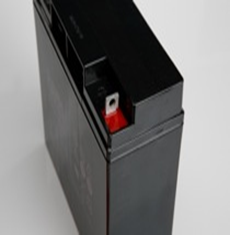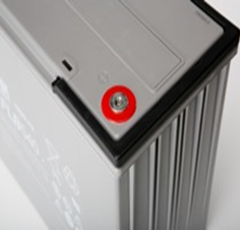A Guide to Terminal Types on Lead Acid Batteries
Replacing a lead acid battery? Confused about the terminal types on offer and want to be sure you are buying the right type? Don’t worry, it’s much easier than you think. So, take a look at this short Blue Box Batteries guide on some of the most common terminal types found on lead acid batteries.
Faston Tabs
Most 'small sealed lead acid' batteries (SSLA), such as the Yuasa NP battery range or the Fiamm FG range, utilise a connector style known as a ‘faston tab’. This type of connector allows for a slide on / slide off style which avoids the need for a nut and bolt, thus making connecting and replacing batteries as simple as possible.

It is important to know which tab size you have on your existing battery to ensure that the new battery you order has the correct tab size for the pre existing connector cables fixed within the equipment the battery is to be installed in to, such as a lawnmower or mobility scooter for example.
Tabs for SSLA batteries come in two sizes, they can be an ‘F1’ type, which means the tab is 4.8mm (.187”) wide, or an ‘F2’ type, which means the tab is 6.3mm (.25”) wide. If you order an F2 type when the connectors are made for an F1, then you may find that the connectors will not fit the new battery, so it’s always best to check first just to be sure.
An F2 terminal tends to be present on batteries installed in applications where the discharge current can be on the greater side, such as uninterruptible power supplies (which discharges the battery very quickly) or equipment using larger SSLA batteries, such as mobility scooters (though larger mobility batteries will use a traditional nut and bolt solution).
F1 terminal batteries are commonly found in equipment where the discharge rate is somewhat lower, such as fire alarms and toys. Some battery sizes offer both F1 and F2 tab sizes, so if in doubt always consult with your battery supplier to ensure that you are purchasing the correct type for your requirements.
Flag Type, Insert
Many larger batteries, including ‘Valve Regulated Lead Acid’ (VRLA) batteries as well as some SSLA, will use a traditional ‘nut and bolt’ connection which threads through a ‘flag / lug’ style terminal and secures the connection in place. This is also a common connection type for motorcycle batteries too.
In many modern VRLA/SSLA batteries this is now being replaced with an ‘insert’ style connection which involves a single bolt (no nut) which inserts down into the battery into a threaded hole. This is also known as a ‘one tool terminal’ as there is no need to hold a nut in place and only a socket set ratchet is required.

In European VRLA terms the most common sizes for insert terminals are between M5 & M8 depending on the rating of the battery. This can be seen on products from such major manufactures as Yuasa, Fiamm, Enersys & Exide. This is a metric sizing referring to the size of the diameter of the bolt thread, so if you have an M5 terminal, this will require a bolt with a 5mm diameter thread.

Some American brands, such as C & D Technologies, will refer to a UNC measurement (Unified National Coarse) or a UNF (Unified National Fine) and will give reference to an imperial measurement followed by an additional number, such as ¼-20 UNC. This means 1/4 inch diameter of the bolt with 20 threads per inch, this would be the course thread. The fine thread size for this bolt would be 28, expressed as ¼-28 UNF.
As shown, bolts required for this type of connection can come in a variety of sizes, so make sure that these are supplied with the battery where possible, or that your existing fixings will be suitable. It is common place for manufacturers to supply fixings with VRLA batteries.
Post Terminals
Post type terminals are most often used on automobile, marine starting batteries and leisure batteries. This type relies on clamp style connectors to secure to the battery terminals to hold the insulation in place.

The most common type of this terminal is the SAE post which is of a plain conical type design, positioned on the top of the battery, each slightly differing in diameter. This style is instantly recognisable to anyone who has replaced a car battery. Another type you may find (predominantly within the early Japanese car market) is the JIS type, which is very similar to the SAE post but smaller in size.
Threaded Post
Much like the ‘insert’ terminal this can be considered very much a ‘one tool terminal’ though rather than a female insert, a male threaded post allows a nut to be threaded down to secure the connection in place.
In VRLA battery terms this type of terminal has become less popular of late as the post on this type (compared with the SAE post terminals described in the previous section) can be narrow and sometimes prone to damage during transport and installation.
For standby applications such as uninterruptible power supplies, emergency lighting and telecoms it is now much more common to find the ‘insert’ terminal type being used.
Thanks for reading our short guide - we hope you have found it useful. Remember that if in doubt, always speak to your battery supplier first. Should you need further assistance then please don’t hesitate to this contact Blue Box Batteries today.
Last battery image from Bigstock.